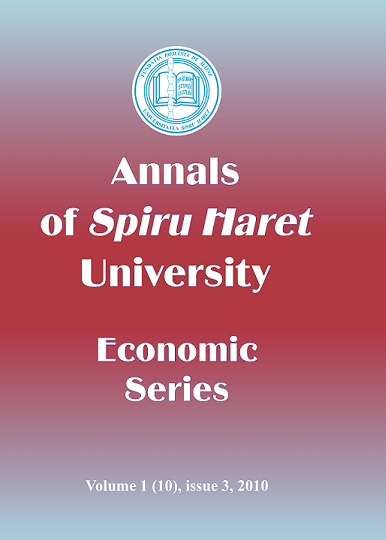Positive evolution in economic forecasting. Case study: the evolution of a company’s capital
Keywords:
economic modelling, forecasting, dynamic analysisAbstract
For the economic sciences, mainly for the planning and organization disciplines, the models display a range of varieties. For the last decades, though, the mathematics-based models seem to be the trend, partly because of their ability to rigorously concentrate the essentials and also to be programmed via the computer-based techniques, thus creating together an unheard of instrument of scientific investigation, a resourceful ‚extension’ of human intelligence.The article herein presents certain medium-term prognosis, via the dynamic modelling, elements of bifurcation theory and the Xpp software. The case study has been the object of a research contract with the business environment.References
• Dobrescu, E., Albu, L. (2006), Dezvoltarea durabilă în România, Editura Expert, Bucureşti.
• Klein, L., Welfe, W. (2003), Principiile modelării macroeconometrice, Editura Economică, Bucureşti.
• Popescu, I., Ungureanu, L. (2006), Paradigma complexităţii economice, Editura Expert, Bucureşti.
• Popescu, I., Ungureanu, L. (2003), Previziunea – premisă a dezvoltării durabile, Editura Fundaţiei România de Mâine, Bucureşti.
• [5] Scarlat, E., Chiriţă, N. (2001), Macroeconomie dinamică, Editura Economică, Bucureşti.
• Tu, P.N.V (1990), Dynamical systems, Springer, Berlin.
• Ungureanu, L., Matei, V. (2008), Using the Modern Technique in Economic Forecast, „Analele Universitatii Spiru Haret, Seria Economie”, Vol. II/2008.
• Ungureanu, L., Galiceanu, M. (2009), Modeling Economic Phenomenon with Elementary Catastrophes, „Advances in management”, India, April 2009, Vol. 2(4).
Downloads
Published
How to Cite
Issue
Section
License
The Annals of Spiru Haret University. Economic Series operates under a Creative Commons Attribution-NonCommercial-ShareAlike 4.0 International License, granting authors full copyright of their work without restrictions. This licensing framework ensures that the journal’s content can be shared and adapted non-commercially, provided appropriate credit is given and derivative works are distributed under the same terms.
By adhering to these principles, the journal reaffirms its commitment to promoting high-caliber research and supporting the global exchange of economic knowledge.




